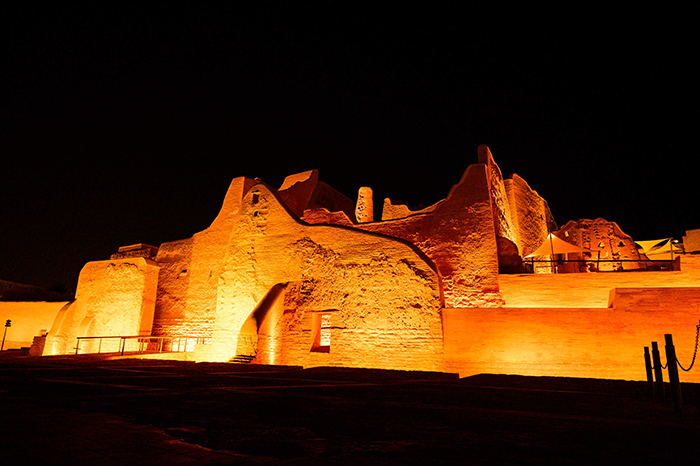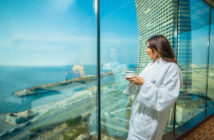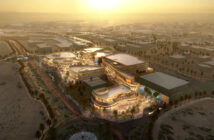BY Fariha Eshrat
If you study the intricate cultural tapestry of Saudi history, you will find Ad-Diriyah is a gem of great significance. This renovated cultural site is an exciting experience waiting to be explored.
Ad-Diriyah is home to the magnificent culture and heritage that Saudi Arabia was built upon. Whether you are new to the country or a longtime resident, the site is a must-visit and a truly breathtaking experience. The splendor of this historical site has also been recognised across the world as it was declared a UNESCO World Heritage Site in 2010.
Architectural marvel
The Turaif district in northwestern Riyadh was the first capital of Saudi Arabia, which is located in Ad-Diriyah. Founded in the 15th century, this heritage site showcases Najdi architecture in it’s most extraordinary form. Najdi architecture is found across the central region of Saudi Arabia and is characterized by the use of mud-bricks, stone pillars and wooden beams in construction. The interior walls are often covered with intricate geometric figures carved with plaster and flowers pressed with molds. Colorful gates, window shutters and panels are also heavily used and can be seen across in the Ad-Diriyah site.
Geographical marvel
Ad-Diriyah was historically an oasis, located by the streams of Wadi Hanifa. This created a location ideal for habitation in this vast desert land as the fertile neighbouring lands served the community’s agricultural needs. and also created an exemplary basis for interacting with the environment. It served as a positive emotional bond between man and nature, and became integrated with the Saudi cultural identity. The location had great impact socially, economically and culturally in the region, allowing Ad-Diriyah to become a model of a thriving oasis community in the desert environment.
Historical marvel
During the 18th and early 19th centuries, Ad-Diriyah became an influential political and religious center. Once the home of the Saudi royal family, the prestigious palaces, magnificent mosques, school, and breathtaking views at the location became its trademark. In 1745, this is where the first Saudi State was established.

In a short time, Ad-Diriyah became an important station along the regional trade route, linking the Arabian Peninsula from west to east, in addition to the control of the pilgrimage route to Makkah. From 1788-1818, during the rule of Prince Imam Mohammad bin Saud, founder of the First Saudi State, who adopted the call of reform of Sheikh Mohammad bin Abdul Wahab, a new page in the history of Ad-Diriyah began. Their message of reform brought along many successes through unity. Their political, military and religious standing attracted huge wealth and prosperity causing an influx of merchants and business in Ad-Diriyah markets. Gradually, Ad-Diriyah also expanded to become a beacon for science and education, and witnessed a flow of students from neighboring states.
In 1818, the Ottoman Empire’s attempted siege resulted in great destruction of the environment and geography of the site. To end the war and limit further damage to his community, the leader Abdullah bin Saud surrendered himself. However, after his great sacrifice, the Ottoman Empire executed him and continued to wage war against the remaining residents of Ad-Diriyah. In the early 20th century, King AbdulAziz Al Saud stored the third state of the Kingdom of Saudi Arabia, reuniting all communities back under one sovereignty.
Hence, Ad-Diriyah remains a national symbol in the history of the Kingdom of Saudi Arabia. These historical tales and now displayed at Ad-Diriyah during the tour in an awe-inspiring light show projected on against the backdrop of the glorious Salwa palace.
Ad-Diriyah as the past and the future
Established in July 2017, the Diriyah Gate Development Authority (DGDA) aims to preserve the culture of Ad-Diriyah, celebrate this historic community, and showcase its history as one of the Kingdom’s most important historical sites and the birthplace of the first Saudi state. Restoring At-Turaif and Ad-Diriyah is one of the many megaprojects underway to boost tourism in the Kingdom, in line with the Vision 2030 reform plan. Everything that will be built around the historical site will be made of mud and in keeping with the architecture of Saudi Arabia’s central Najd region. Recent restoration projects have reanimated the palace and city ruins. Making Ad-Diriyah known globally as a landmark that celebrates Saudi culture and history also part of the goal. As Ad-Diriyah highlights the architectural, diplomatic and artistic legacy of Saudi Arabia, the project reflects the government’s attention towards the development and preservation of the national heritage. Highlighting the Saudi people’s contribution to the episodes of foundation and unification of the Kingdom of Saudi Arabia is one of the key elements of the project of the Custodian of the Two Holy Mosques which was recently approved by the State.
This restoration included all the buildings’ internal and external elements, rehabilitation of site’s buildings for the museum and administrative uses, preserving the elements of existing buildings, restoring and protecting them from deterioration, restoring of building frontispieces that are overseeing the site’s streets and pathways. There are many mosques on the heritage site which have been recently restored to their full glory. This includes one of the most famous mosques in all of Saudi Arabia—the Sheikh Mohamed bin Abdulwahab mosque, where Sheikh Mohammed bin Abdulwahab used to be its imam and deliver sermons. His home is also on the premises. The Al-Dhwaihrah Mosque and the Imam Mohammed bin Saud Mosque are other famous mosques being renovated.
Since then multiple projects have been successfully conducted as Ad-Diriyah is ready to re-emerge as a symbol of heritage for the Kingdom. For the 2018–19 ABB Formula E Season, Ad-Diriyah hosted the season opening race just a few kilometers away. Diriyah Season held during late 2019 and Winter Season held through early 2020 allowed millions of enthusiastic visitors to experience the wonder of Ad-Diriyah. The serenity of the location allows visitors to experience the historical significance of At-Turaif, home of Saudi Arabia’s founding fathers and honor their legacy by showcasing Ad-Diriyah as the jewel of the Kingdom.
Ad-Diriyah Tour
The DQ Living Team had the wonderful experience of touring across the Ad-Diriyah Project at At-Turaif before it re-opens for public access. This amazing tour consisted of some of the most exciting historical sites and well managed museums we have ever seen, below is an overview of what’s in store for future visitors.
Salwa Palace
As we walked through the restored mud-brick houses of the vast palace, our tour guides narrated the enthralling history of the site. Starting from the breathtaking view of Wadi-Hanifah from the top of the palace, to the 3D figures projected in the dining spaces, the mosques and the corridors to showcase how the people of the past had traditionally used these spaces, the attention to detail in recreating an immersive historical experience was exceptional. Our tour guides explained the architecture in beautiful practical context, pointing out to even the smallest details like the preserved sundial at the mosque used for estimating prayer time and the small seats of the students still remaining in the palace school. We walked through the houses and streets inside the palace, where you will come across the horse stable, the various museums listed below, the palace courtyard and an awe-inspiring light show projected against the massive palace.
 Ad-Diriyah Museum
Ad-Diriyah Museum
The museum aims to introduce the history of the Saudi First State through a number of exhibits and activities. The museum offers an open air show among the restored ruins along a special corridor devoted for this purpose that consists of information screens on the most important parts of the palace and historic events that took place there, in addition to the closed museum display, which includes panels, mockups, relics and documentaries.
Social Life Museum
The museum sheds light on the daily life of Ad-Diriyah residents, their historic customs and traditions and the tools they had used to bring prosperity during the Saudi First State. The museum is located in Omar bin Saud Palace and the surrounding mud buildings.
Military Museum
This exhibit displays war tools from famous battles, everything from small knives and ancient guns, to famous swords used by rulers, to a replica Ottoman cannon is available to showcase the defense system used in those times. The military museum is located within the buildings neighboring the Thinayan bin Saud Palace.
Arabian Horse Museum
The museum aims to introduce the Arabian horses and the proper ways of horse breeding that were used in Ad-Diriyah. The museum is located within the neighboring buildings of Imam Abdullah bin Saud Palace and the horse stables next to the palace.
Trade and Monetary Museum
The museum is located within the buildings of ‘Bait Al Mal’ (Money House) and Sabalat Mody (free drinking water fountain). The museum display the economic prosperity that Ad-Diriyah had witnessed, in addition to displaying a number of coins, scales and endowments.
Visitor Center
The visitor center offers tourist-guiding services to the visitors of Turaif neighborhood. The center is a new building located opposite to Salwa Palace
Light and Sound, and Multimedia Shows
The show offers audio drama narrating the history of the Saudi First State in addition to spotlights over Salwa Palace using light and sound technology, in addition to five shows of multimedia at selected locations in the neighborhood. The presentation gave our team a great sense of inspiration. It highlighted the growth and strength of this Kingdom in the most extraordinary way possible and was a beautiful way to end our tour.
Photo credit to Glenn Mer Pilandre




